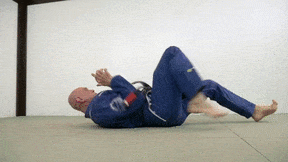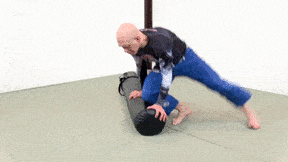
Let’s face it… BJJ requires you to become adept at using many highly specialised movements that you hardly ever use in the rest of your life. The more smooth and instinctive these movements become then the better you’ll be able to flow on the mats.
Drilling is the secret sauce when it comes to internalising unfamiliar motions, but it can be hard to get to the dojo as often as you would like or even to find a training partner willing to let you bang out rep after rep with them.
Fortunately there are BJJ solo drills to help fill the void. Being able to drill at least some of these movements yourself at home or at the dojo before class will definitely help you.
Here are 10 drills you can do on any floor and then 7 more drills that you can do on a punching bag or grappling dummy.
Table of Contents
Drills 1-10, Solo Shrimping for Better Hip Movement

Even if you’re new to jiu-jitsu you’ve probably heard someone say that, ‘The secret to jiu-jitsu is in moving the hips‘.
The hips are incredibly important in grappling – being able to move them correctly allows you to escape bad positions, stop guard passes, generate power to your submissions, and set up your guard sweeps.
Most people only know one or two ways to shrimp, but there are many more methods, all of which develop your hips moment and overall body coordination in different ways.
In this video you’ll learn 10 different drills that you can do by yourself anywhere that you’ve got a floor or a mat available to you.
(Download a PDF summary of these 10 solo drills for free from this page here.)
11, Toreando Guard Pass Solo Drill and Application

One of the most popular guard passes in BJJ is the ‘Toreando” or bullfighter pass.
This movement-based pass is a white-belt favourite because it’s relatively simple to use, but more sophisticated versions of it get used all the time in high level competition too.
Most people trying this pass for the first time get messed up on the footwork. In this drill which can be done on a heavy bag, a grappling dummy, or even a pile of pillows you’ll learn how to perfect the footwork for the powerful Toreando pass.
Plus I’ll teach you the application of the footwork against a real opponent.
Check it out…
12, Kneemount Spin Solo Drill and Application

The kneemount is a terrible position for your opponent to be caught in, so he’ll twist, turn and squirm to get out.
(Click here if you want a downloadable breakdown of the kneemount and the other major BJJ positions.)
But if you know how to spin from side to side you can keep him from getting out, plus look like a BJJ superhero at the same time.
This movement looks a little like breakdancing but if you try it out on a heavy bag you’ll quickly see that it’s not as tough as it looks.
Check out the drill and the application of it in the video below…
13, Low Spin Solo Drill and Application

In the previous video we used the kneemount spin to go from side to side while high above our opponent.
The low spin is a similar-but-different movement that’s used by almost all black belts. It basically teleports you behind your opponent and can be used to counter escape attempts, expose the back, and create submission opportunities.
I found this a challenging movement to learn at first, and if I’d known this drill as a purple belt I would have been able to add the low spin to my game much earlier!
Here’s the drill and application…
14, Drop Spin Solo Drill and Application

The drop spin (aka ‘the People’s Elbow’) is a movement that I first learned from Marc Laimon.
It’s yet another way to get behind your opponent’s defenses, and it’s a particularly effective way to follow up on a successful guard pass.
This technique is MUCH easier to learn if you can drill it a few times by yourself, in peace and quiet, on a heavy bag. But once you master it you’ll start being able to take the back much easier!
(Click here for a great tip for maintaining the back position once you get it!)
15, Kickpass Guard Pass Solo Drill and Application

One of my favourite guard passes is called the ‘kickpass’, also known as the ‘X pass’.
This is a standing guard pass where you force your way into a loose half guard position and then use a dynamic backwards swinging kick to free your leg and come forward directly into a dominant position like knee mount.
In the video below I’ll show you how to improve execution of this movement as a solo drill that you can do on a heavy bag at home or before class. Then I show how to apply this movement against a real opponent.
Check it out – it’s a cool little video and drill and could really help you!
16, Headmount Heavy Bag Drill and Application

Don’t you hate those super-squirmy guys? Even if you pass their guards they just shimmy their flexible gumby legs around and you’re right back in guard where you started from.
Here’s one of my biggest tips on how how to shut down their game and pin them to the floor like a butterfly on a lepidopterist’s museum display board!
The central concept is to pike up and use what I call the ‘Head Mount’ in which you use your head to pin his abdomen in place while you circle to a better position.
(It’s actually quite easy to drill this position on a heavy bag on your own.)
In the video just below I show you how to use the headmount, transition in and out of the it, and how to practice it without a training partner.
Check it out:
17, S Mount Attack Drill and Application

One of the most dominant forms of mount is called the ‘S mount’. It puts a TREMENDOUS amount of pressure on your opponent’s diaphragm making it hard for him to breathe.
In S mount your opponent is in constant danger of getting caught in an armbar because all it takes for you to apply the submission is just one tiny transition.
Here’s a drill that I learned from Combat Submission Wrestling founder Erik Paulson that takes you from sidemount directly to S mount, even against a very defensive opponent.
Drill this and then armbar someone from S mount for me, OK?
MORE: The Roadmap for Brazilian Jiu-Jitsu, a Downloadable Guide to Learning BJJ Fast!
If you’re relatively new to BJJ you might want to grab my free guide to learning BJJ fast called A Roadmap for Brazilian Jiu-Jitsu.
In it you’ll learn…
- The 6 major positions of BJJ
- A complete strategy for dominating your opponent
- The 3 most important variations of guard
- The first submissions you should learn from every position
- How to learn BJJ more quickly
It’s already helped more than 100,000 people and it can help you too!
Plus it’s 100% free to download. Just enter your email below and I’ll send it to you!
Take care and good luck with your training!
Stephan Kesting



